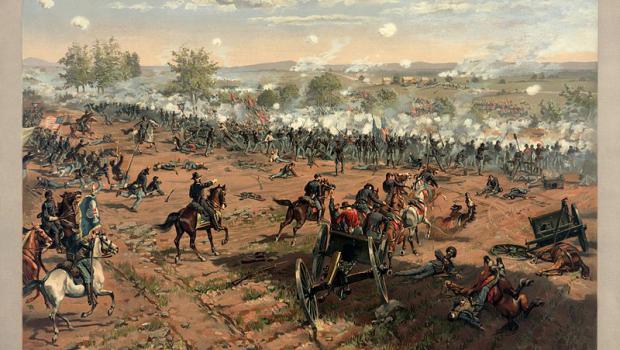
Above, print of the painting "Hancock at Gettysburg" by Thure de Thulstrup, showing Pickett's charge (Wikimedia Commons)
About the Course
POLISCI 22SC
Prerequisites: None
Our understanding of warfare often derives from the lofty perspective of political leaders and generals: what were their objectives and what strategies were developed to meet them? This top-down perspective slights the experience of the actual combatants and non-combatants caught in the crossfire. This course focuses on the complexity of the process by which strategy is translated into tactical decisions by the officers and foot soldiers on the field of battle. We will focus on three battles in American history: Gettysburg (July 1863), the Battle of Little Bighorn (June 1876), and the Korengal Valley campaign in Afghanistan (2006-2010). In addition to reading major works on these battles and the conflicts in which they occurred, we will travel to Gettysburg, Pennsylvania, and the Little Bighorn battlefield in Montana. The course's battlefield tours are based on the "staff rides" developed by the Prussian Army in the mid-1800s and employed by the U.S. Army since the early 1900s. While at Stanford, students will conduct extensive research on individual participants at Gettysburg and Little Bighorn. Then, as we walk through the battlefield sites, students will brief the group on their subjects' experience of battle and on why they made the decisions they did during the conflict. Why did Lt. General Longstreet oppose the Confederate attack on the Union Army at Gettysburg? What was the experience of a military surgeon on a Civil War battlefield? Why did Custer divide his 7th Cavalry troops as they approached the Little Bighorn River? What was the role of Lakota Sioux women after a battle? Travel will be provided and paid by Sophomore College (except incidentals) and is made possible by the support of the Center for International Security and Cooperation (CISAC). The final part of the class covers contemporary military conflicts discussing what the US public, political leaders, and military commanders have learned (and not learned) from the past. The course is open to students from a range of disciplines; an interest in the topic is the only prerequisite.
Read the article written about the 2012 Face of Battle Course.
Click to hear the faculty talk about the course
Click see video about the course
Instructor Bios

Scott D. Sagan is the Caroline S.G. Munro Professor of Political Science, the Peter and Mimi Haas University Fellow in Undergraduate Education, and Senior Fellow at the Center for International Security and Cooperation (CISAC). He is a specialist on nuclear weapons and international security and the recipient of four major teaching awards. His distant relative, Major General George E. Pickett, led the final Confederate charge at Gettysburg.
 Joseph H. Felter is a senior research scholar at Stanford's Center for International Security and Cooperation (CISAC) and a research fellow at the Hoover Institution. He is a specialist on counterinsurgency and counterterrorism. Before coming to Stanford, he served as a career U.S. Army Special Forces officer with operational combat deployments to Panama, Iraq, and Afghanistan.
Joseph H. Felter is a senior research scholar at Stanford's Center for International Security and Cooperation (CISAC) and a research fellow at the Hoover Institution. He is a specialist on counterinsurgency and counterterrorism. Before coming to Stanford, he served as a career U.S. Army Special Forces officer with operational combat deployments to Panama, Iraq, and Afghanistan.



